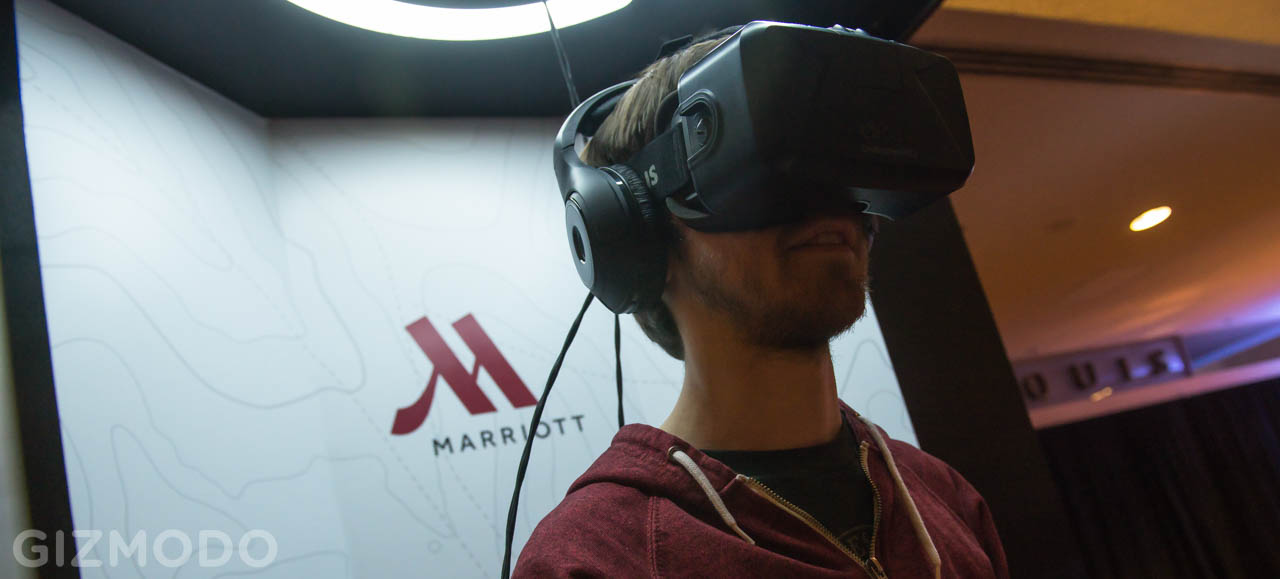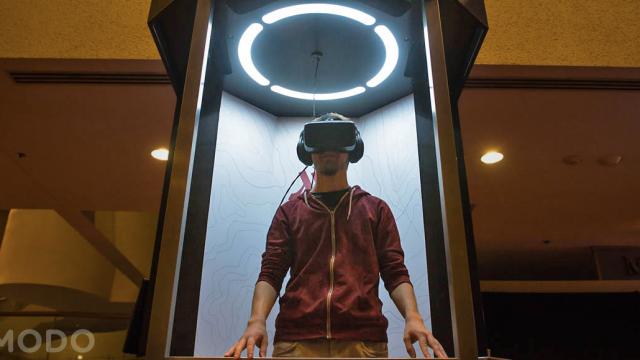Virtuality is still stuck in an awkward liminal stage. Sony introduced Morpheus, Samsung’s Gear VR is just around the corner, and the Oculus Rift continues to showcase the best the platform has to offer. But it’s a technology not easily accessible. Instead, it’s still relegated to strange demos and experimental experiences — and this could be one of the weirdest.
Marriott Hotels has created what it calls “the teleporter”. But as anyone familiar with the technologies aboard the Starship Enterprise would know, this 3m tall(ish) machine resembles more of a mobile holodeck, a contraption built specifically to simulate your surroundings. That isn’t done by just strapping an Oculus Rift DK2 unit to your face — so this holodeck also recreates heat, smell, movement, wind, and even mist.
Once securing the Oculus Rift to my beautiful mug, adjusting my headphones, and reaching out blindly to get my bearings, I find my digital self in a swanky hotel bar and lounge, scanned piece by piece from a real Marriott lounge in Baltimore and piped into Unreal Engine 4. The experience was ominous. My virtual avatar tiptoed through the maze of empty chairs and tables. I could hear chatter, laughter, the clinking of glasses, but as I glanced around my 360-degree virtual environment, I couldn’t see anyone. The room was completely empty, and I was on a fixed path.
If you want to know what I’m actually looking at, click here.
Up ahead of me was a painting of some sort. No, a map. As I stepped closer I could make out the lines and contours of the image. “OK, that’s definitely Hawaii.” Then the map sucked me in. I was whipped through a greyish display of sprawling tendrils, which I can only assume represent the inner workings of space-time. I was like the Tardis spinning out of control or Bill and Ted hunting for a new historical celebrity (or whatever your time travel preference may be).
Then there I was, standing on a beach with the Pacific stretched out before me. Unlike the digitally rendered hotel I had just left, this locale was shot in real time. Thanks to pumps on board the teleporter, I could feel the ocean mist against my skin. Vents released what I can only accurately describe as “beach smell.” The moving floor created a mechanical approximation of sand.
After 30 seconds of my beach excursion I was snapped back to the hotel lounge, only this time approaching another image. As I got closer I could make it out. “Next stop, London.” Looking over the edge of Tower 42 to be more specific. The moving plate beneath my feet lounged me forward as I grabbed the guard rail in front of me. I could hear a bell ringing, cars honking in the distance.
However, unlike a beach, which doesn’t require an amazing amount of detail, the sprawling cityscape of London does. Oculus VR’s DK2 unit provides excellent head tracking but virtual reality’s 1080p resolution can’t quite keep up. After 30 seconds, I snapped back to Baltimore and the program faded to white. I had just “travelled” thousands of miles in one minute.
Marriott devised this globetrotting adventure with digital studios Framestore, which created all those pretty visuals Alfonso Cuarón’s Gravity (not to mention Aha’s brilliant “Take On Me” music video in 1986), and Relevent, a New York-based agency that specialises in experiential advertising. The duo teamed up before to create HBO’s “Ascend the Wall” VR experience, a similar set up where Framestore created the visuals while Relevent provided the physical interaction.
Although barely longer than a minute or so, the techniques required to visually capture a sandy beach in Hawaii or the second-tallest tower in London had to be built from scratch, says Framestore’s executive creative director Mike Woods. “There’s the technical reason of pulling off but then there’s how your head works, how your neck works, how your eyes work. ” he says. “We had to come up with a way where we had to shoot everything we needed to shoot and put together in a way that almost faithfully recreates what your head, neck, and eyes do, and that’s a giant feat.”

But the visuals were only half of it, Relevant stepped in to make the VR experience feel as real as possible. As Woods and his team traveled to Hawaii and London to capture video, Relevent would send its own small team to record what they call a “sensory survey.” This non-technical process only required a couple people to stand next to the camera and describe every sensation they were feeling, whether wind, temperature, vibrations, or sound. Combining all these observations, Relevent fabricated a booth, equipped with high-pressure nozzels, six separate fans, a scent machine and heat lamps, to faithfully recreate the world you’re seeing virtually.
“When you travel places, it’s not just your eyes and ears,” says Ian Cleary, a VP at Relevent. “Your whole life is just sensory inputs…your brain doesn’t really care if that stimulation is real or virtual. If you create these experience well enough, your mind should register it as ‘I was there’ and not ‘I watched something.’”
Marriott’s teleporter hasn’t quite reached that level of sophistication. For true immersion, VR will eventually have to transcend 1080p. It does a fine job of making a beach, London tower, or boozy lounge feel immersive but being able to spot pixels will always keep me from thinking its real.
As for the sensory additions, capturing smell was a completely weird experience and easily the most convincing piece of this holodeck puzzle. The moving ground is a bit wonky and it’s all very loud. Hearing loud mechanical movements and fans wheezing overhead, even over the ambient sound in my headphones, creates a disconnect. These small moments make it clear that you’re in a strange cage with a screen strapped to your face.
Also, the power behind Marriott’s VR experience isn’t something you’re likely to have in your home. Even though the Rift’s screen only displays 1080p, the whole rig renders video at 4K resolution at 75 frames-per-second using a custom computer with a Titan Black graphics card. Two Marriott Teleporters will be travelling to eight cities in the U.S., including New York, Boston, Washington, Atlanta, Dallas, San Diego, San Jose, and San Francisco. You can check here for specific dates and locations if you’re so inclined.
Despite its limitations, I couldn’t shake the feeling that machines like the Marriott’s teleporter, HBO’s “Ascend the Wall” demo, and other content creators who are trying to creates these sensory experiences, are building the early stage holodeck prototypes, like Da Vinci’s flying machines before the Wright Brothers refined the concept. Only it won’t take centuries this time, maybe only a decade. Either way, it’s a future that seems inevitable.
“We’ve gone from tiny little TVs in our living room, to bigger TVs, to 3D TVs, to cinema screens, to IMAX screens. It’s all going one way. It’s immersion,” says Woods, “and this is it. This is the ultimate final step.” Considering the sci-fi technology at work, I prefer to call it the “final frontier”.
